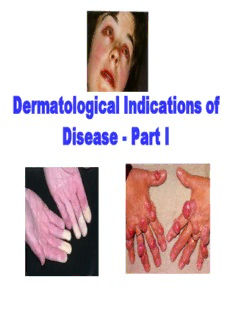
Dermatological Indications of Disease PDF
Preview Dermatological Indications of Disease
Dermatological Indications of Disease - Part I This 56 year old man has a history of headaches, jaw claudication and recent onset of blindness in his left eye. Sed rate is 110. He has: A. Ergot poisoning. B. Cholesterol emboli. C. Temporal arteritis. D. Scleroderma. E. Mucormycosis. What does an elevated sed rate indicate? What causes polyclonal gammopathy? Alpha-2-chymotrypsin and vitamin D binding protein Alpha-1-antitrypsin Alpha-2-macroglobulin TBG & transcortin Haptoglobin, ceruloplasm Transferrin Alpha fetoprotein Prebeta lipoprotein (VLDL) (HDL)Alpha-1-lipoprotein Beta lipoprotein(LDL) includes SAA Complement Fibrinogen IgA(beta gamma IgM bridging) IgG Polyclonal gammopathy = infection, chronic liver disease and collagen vascular disease Lysozyme = myelo- monocytic leukemia (Kidney damage and low K+) What are the types of large vessel vasculitis? Large vessel vasculitis: 1. GCA complex = Cranial arteritis Aortic arch syndrome Fever/wasting syndrome(FUO) Polymyalgia rheumatica 2. Takayasu’ arteritis (Pulseless disease) – age < 40 claudication (arms more than legs) bruits arteriogram abnormal 3. Behçets syndrome* (“Old Silk Road” disease) *affects all size vessels This patient has antithyroid antibodies. This is: • A. alopecia areata. • B. psoriasis. • C. tinea. • D. lichen planus. • E. syphilis. Search for Hashimoto’s or Addison’s or other B8, Q2, Q3, DRB1, DR3, DR4, DR8 diseases. This woman was placed on piroxicam 3 weeks ago. She has 20% of her body involved with erythema and targetoid lesions. Her dermatitis was preceeded by fever, chills, headache and GI upset. Labs show anemia and neutropenia. Which is most likely present? A. Erythema Multiforme B. Kawasaki’s disease C. SJS/Toxic Epidermal Necrolysis D. Systemic Lupus Erythematosis. E. Staphylococcal Scalded Skin Syndrome SJS and TEN are almost invariably due to drugs. Drugs causing SJS/TEN 7. Drugs: West: 1. oxicam NSAIDs, ie perioxicam (Feldene) 2. sulfas East: 1. carbamazepine (Tegretol) – HLA - B*1502 2. allopurinol – HLA - B*5801 The Fas ligand, a member of the TNF family, binds to the receptor (FasR) creating cell death. Granzyme B from cytotoxic T cells also plays a role, as does granulysin. This woman with an elevated CPK has a chief complaint of: A. itching. B. joint pain. C. muscle weakness. D. cold fingers. E. vomiting. Medscape Remember the association with ovarian, breast, GI and lung cancer! May be drug induced – ie. hydroxyurea, penicillamine, statins, cyclophosphamide, etanercept What is the conjectured cause of this condition? A. Demodex mite (Bacillus olernius) B. Corynebacterium C. Pityrosporum D. Borrelia E. Tinea Many have SIBO* and respond to rifaximin. Painting by Ghirlandaio What would you tell this patient? Keratopathy. Corneal melting! Corneal vascularization and thinning. Associated with PD. What are the causes of flushing? *Small intestional bacterial overgrowth A 25 y/o Ethiopian female presents with the following eye changes. She initially had white nodules form in the upper eye lid. This is: A. allergic conjunctivitis. B. Shipyard disease. C. keratoconjunctivitis sicca. D. trachoma. E. Acanthamoeba.
Description: